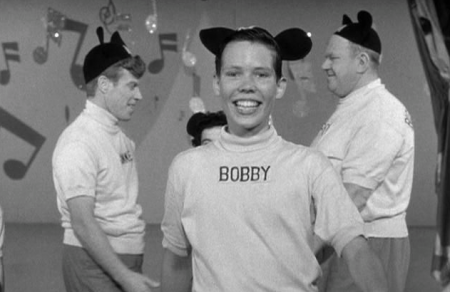The one thing I always remember about Bobby Burgess, in addition to his tremendous skill as a dancer and performer, is his brilliant, never-ending smile. After reading Bobby’s delightful new memoir “Ears and Bubbles” and getting the chance to talk with Bobby himself, his infectious smile comes through in his writing, his colloquy, and his example of a life well lived.
Bobby’s memoir is a wonderful chronicle of not only his good life, but also the inner workings of two beloved television shows in which Bobby starred in: the original “Mickey Mouse Club,” which ran from 1955 to 1959; and “The Lawrence Welk Show,” where Bobby was a series regular from 1961 to 1982 (and which is still one of the highest-rated shows on public television stations today). Given the perennial popularity of both programs, Bobby has been a television staple for almost 60 years, an unprecedented and amazing accomplishment.
While we all like to think about Walt Disney as our surrogate uncle, he actually was Bobby’s “Uncle Walt” (Walt wanted the Mouseketeers to call him “Uncle Walt,” but, as Bobby told me, “they were 1950s kids who respected their elders, so they called him ‘Mr. Disney’”). And when Bobby was hired on “The Lawrence Welk Show,” Lawrence Welk himself (who also had a strong work ethic and who didn’t suffer fools gladly) said of Bobby, “I never had any trouble with Bobby because he was raised by Walt Disney.”
It’s hard to believe, but Bobby’s big television break on “The Mickey Mouse Club” almost didn’t happen. Bobby recounts the story of when he was 12, he was in the cast of “Peter Pan,” the musical adaptation of the story directed by Jerome Robbins and starring Mary Martin. The show was in rehearsals in Los Angeles and was preparing to move to Broadway. One night after rehearsal, Bobby went with his family to a Los Angeles Angels baseball game and he cheered and screamed so loudly at the game that he lost his voice. When Bobby showed up at the stage the following day for rehearsal and he couldn’t sing, he was fired from the job. Bobby writes about the event: “I was crushed, but if I had gone to New York, I wouldn’t have gotten ‘The Mickey Mouse Club.’ It would have led my life in a very different direction. I guess everything happens for a reason, and in my case, it certainly did.”
Any fan of “The Mickey Mouse Club” will love reading Bobby’s first-hand account of the show, its cast, the experience of growing up on the Disney Studios lot, and of working directly with Walt Disney. The book is also full of many fun stories of appearances that the original Mouseketeers have made over the years. (I almost got all verklempt on the phone when Bobby started singing the “Mickey Mouse Club Alma Mater” song to me.) Bobby along with some of the other living original Mouseketeers from the 1950s are preparing for some exciting events surrounding the 60th anniversary of “The Mickey Mouse Club” which will be taking place at the 2015 D23 Expo (https://d23.com/d23-expo/) in Anaheim, California next August.
Bobby’s tremendous run for over 20 years on “The Lawrence Welk Show” is also well documented in the book. He talks in detail about working with his three dance partners (Barbara Boylan, Cissy King, and Elaine Niverson), the great musical cast of the show, and about the wonderful creative environment that Lawrence Welk provided for him on the program. He states that “Lawrence instilled confidence in me since he trusted me to do my own choreography.” Bobby regularly consulted with the show’s camera team every week as well to set the camera angles that “were essential to how well the dance was enjoyed by the TV viewing audience.” Through all of his choreography, creativity, and hard work, he states that: “To dance in front of that great 25-piece Lawrence Welk band every week was always truly inspiring.”
There’s no slowing down for Bobby. He continues with his dancing career today by participating in the “Stars of the Lawrence Welk Show” tours in venues across the U.S.A. He also runs along with his family a successful cotillion program in Southern California which teaches children about dance, etiquette, and manners in a structured setting (for more information, visit their website at http://bobbyburgesscotillion.
Bobby talks happily of his “three families” in the book—his actual family (Bobby married Kristie Floren, the daughter of “Lawrence Welk Show” accordion player and lead musician Myron Floren, on Valentine’s Day in 1971; they are the parents of four children), his “Mickey Mouse Club” family, and his “Lawrence Welk Show” family. He knows that he is truly a fortunate guy.
He writes: “After all the TV shows, touring, traveling around the world, and having such a full life, what’s really most important to me? That’s easy—my family, of course. And coming in second, having a wonderful life in my chosen profession. Happiness to me is finding the right spouse and being happy in your work. I got lucky with both.”
And that’s worth smiling about, indeed.

